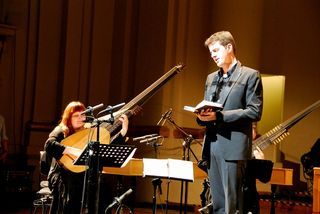|
Back
Remembrance of Centuries Past New York
Zankel Hall, Carnegie Hall
10/14/2022 -
Antoine Boësset: Nos esprits libres et contents – A la fin cette bergère
Anon.: El baxel està en la playa – Pues que me das a escoger
Maurizio Cazzati: Ciaccona à 3 con il suo Balletto
Henry Le Bailly: Yo soy la locura (Passacalle de La Folie)
Pierre Guédron: Aux plaisirs, aux délices bergères – Dessus la rive de la mer, ya trois filles
Etienne Moulinié: Concert de différents oyseaux – Orilla del claro Tajo – Non speri pietà – Enfin la beauté que j’adore
Giovanni Girolamo Kapsperger: Intavolatura di chitarrone, Book I: Toccata Arpeggiata
Michel Lambert: Ma bergère est tendre et fidèle
Giovanni Antonio Pandolfi Mealli: Sonata for Violin, "La vinciolina", Opus 4, No. 6
Marc-Antoine Charpentier: Sans frayeur dans ce bois
L’Arpeggiata: La Dia Spagnola
Philippe Jaroussky (Counter-Tenor), Dorin David Sherwin (Cornetto), Kinga Ujszaszi (Baroque Violin), Maximilian Ehrhardt (Baroque Harp)
L’Arpeggiata Christina Pluhar (Artistic Director and Theorbo)

C. Pluhar, P. Jaroussky (© L’Arpeggiata)
“Has it struck you that the music which is regarded as the most sublime in western civilization... is called baroque?”
Pierre Schaeffer
“Baroque: To underline the excesses of its emphasis, of its eccentric redundancy, its noisy abundance of details, as opposed to the clearer and sober rationality of the Renaissance.”
During the hour of music by L’Arpeggiata last night, not a single word was spoken, the dynamics of trumpet, violin and voice reached fortissimo only twice. And yet Christina Pluhar offered nothing less than enchantment.
L’Arpeggiata was derived from a piece of 17th Century music, the Toccata Arpeggiata by Giovanni Girolamo Kapsberger, but Ms. Pluhar’s ensemble, after 20 years, is far more. She has essayed jazz (not very well), her previous concert included Leonard Cohen’s Hallelujah (an over‑studied interpolation) and opera from Monteverdi to Handel.
Her expertise as conductor, musical director and theorbo player is unquestioned, as is her frequent collaborator, counter‑tenor Philippe Jaroussky. Last night, though, she made the daring decision to strip down L’Arpeggiata to the basics, offer composers whose names were familiar to only the most passionate Baroque fanatic, and fill Zankel Hall to the rafters.
Even more, not a single whisper, cough or rustle could be heard from an audience enraptured, only occasional applause between two three relatively more showy works.
Ms. Pluhar eschewed the usual Baroque aggregation of winds, horns and continuo. The main players were five. Doron David Sherwin’s Baroque Cornet (cool, not brassy, never totally in tune, so one realized this was centuries before our modern orchestras); one Baroque Violin (hardly a Strad, but with the most nimble playing by Kinja Ujszaszi); the subliminal sounds of Maximilian Ehrhardt’s Baroque Harp, and David Mayoral’s percussion.
Though this was not the percussion of Ringo Starr or Buddy Rich. The little snare drums, the other tiny groups of instruments, offered soft‑hued colors, delicate beats. Instead of “drums”, Mr. Mayoral gave us understated tempos, modest tones.
Without a harpsichord (who in the early 1700’s had heard, heard of, possessed one?), Christina Pluhar strummed her theorbo, regulated the balance of the ensemble’s circumscribed sounds, ensemble colors which obscured words which wouldn’t be permitted in today’s Woke culture.
The words, in 17th Century Italian and French, were sung with that consistent treble beauty by the world’s most famous counter-tenor, Philippe Jaroussky, he who turns Monteverdi or Vivaldi into thrilling 19th Century‑style opera.
Those names weren’t here. For this was the mere beginnings of an era which climaxed with Bach and Handel. This was “household” or “courtly” music, played with lute and voice, for the entertainment of Louis XIII–blossoming a half‑century later into Lully’s extravaganza ballets.
I confess momentarily confusing the order of the songs, sung with a caesura rather a break. The words, though, were astonishing. One Luis de Congó wrote of paradise being “a house with a back door, a spotless bed with a lady of good repute (sic!) and lots of money.” An anonymous poet wrote of raping three beautiful women (“Like it or not, you shall kiss me:... He threw her upon the grass and had his way with her...”
Other voices were more benign (though one shepherdess prefers her dog to the singer). All of the songs, without exception, transported us back three centuries, the dulcet sounds and tender vocal lines, never sentimental or overly-emotional.
These songs were meant to be improvised, but Ms. Pluhar allowed only a single improvisation. La Dia Spagnola started with soft theorbo, proceeded with cornet, violin and drums. The sounds were never flashy, the ambiance had a few Baroque surprises and a very Classical balance.
The players were superlative, the notes were inspired, and we, in the words of an Elizabethan poet, “followed with accents sweet.”
Harry Rolnick
|